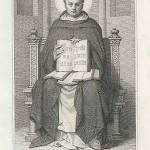Continuing my look at Chapter 3 of the Compendium Theologiae. The complete series is here.
Thomas was talking about how one thing moves (i.e., causes change in) another thing, and referenced Medieval astronomy as an example. Because the motion of the heavenly bodies figured largely in Aristotle’s notions of the Unmoved Mover, we should spend a little time on it.
To Thomas, as to Aristotle—and, in fact, to everyone who lived before the invention of the telescope—the stars and planets seemed to be of an entirely different order of creation than the things of this earth. This is hard for us to understand: we are so used to thinking of outer space as so much vacuum, the stars as so much incandescent gas, the planets as moving according to the laws that govern the movement of the wind, or of avalanches, or of cars on the freeway. But until Galileo and his contemporaries used telescopes to look at the stars and planets and saw so much up there that was reminiscent of so much down here, the “superlunary” bodies were thought to be perfect, incorruptible spheres, of a higher nature than lowly terrestrial matter.
Astronomy, to the predecessors of the telescopic age, wasn’t regarded as a physical science at all, but as a branch of mathematics. It was more about being able to predict where the heavenly bodies would be seen at a particular time than it was about understanding the motion of brute matter. The goodness of a model of the heavens was judged based on its simplicity and the quality of its predictions, not on any modern notion of the laws of physics.
Aristotle went beyond this, to ask why it was that the heavenly bodies moved. They were not moved by the wind, as a leaf is blown in the autumn, or by the water, as a log in a river, or by the hand of man, as trees are fashioned into a house, and yet they moved. He reasoned that they must be moved by each other, not indeed as you or I move a chair from one place to another, but by what he called “final causality”. And he reasoned that those changes we see on earth that seem to have no obvious cause must be driven in a similar way.
He was wrong; but Aristotle was a skilled observer, and in many ways he was also right. He had no notion of gravity, that discovery of Isaac Newton, but we now know that the motion of the planets around the sun is determined by the relative masses of the sun and the planets. Together, the gravity of the sun and the moon drive the tides (a fact quite familiar to the ancients), and the earth’s motion relative to the sun drives the seasons.
In short, Aristotle’s notions are not entirely farfetched, even if he was limited by the nature of his instruments: his own two eyes. Newton famously said that he stood on the shoulders of giants, and Aristotle was one of them.
To Be Continued.









